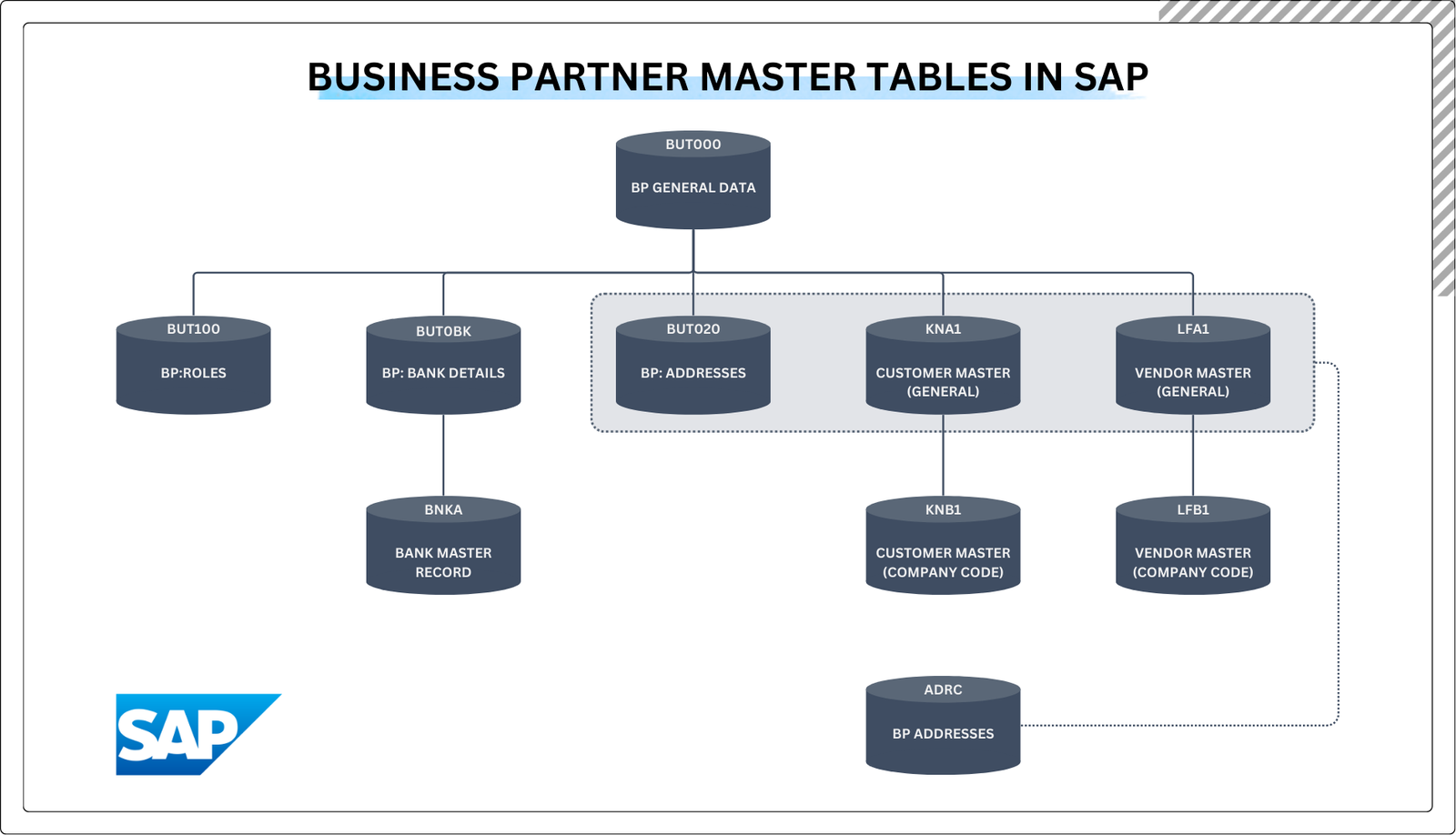The Business Partner Master (BP Master) is the central master data object for managing business relationships in SAP. This article provides an overview of the primary tables and structures associated with the BP Master.
Understanding the BP Master Table Structure
The BP Master is built upon a structure of multiple tables. Prior to S/4HANA, SAP systems used separate master data for Customers and Vendors. With S/4HANA, the BP Master was introduced as unified approach. However, it’s important to note that even in S/4HANA, the underlying tables storing customer and vendor specific data remain distinct. This historical context is important for understanding the current table landscape.
Key Tables in the BP Master
Here’s a list of essential tables related to the SAP Business Partner Master:
| Table ID | Table Name | Description |
|---|---|---|
| BUT000 | BP General Data | Stores general data for the Business Partner, applicable across all roles. |
| BUT100 | BP Roles | Contains the BP Roles (functions) assigned to a Business Partner. |
| BUT0BK | BP Bank Details | Holds bank details like bank codes and account information for the Business Partner. |
| BNKA | Bank Master | Stores bank information associated with the bank codes used in BP Master and elsewhere in SAP. |
| BUT020 | BP Addresses | Contains address numbers assigned to the Business Partner, linking to detailed address information. |
| ADRC | Addresses | Stores all address data in SAP, including addresses used in BP Master and other master data objects. |
| KNA1 | Customer Master (General) | Stores general customer information for Business Partners with a customer role. |
| KNB1 | Customer Master (Company Code) | Holds company code specific customer information, such as reconciliation account, for customer BPs. |
| LFA1 | Vendor Master (General) | Stores general vendor information for Business Partners with a vendor role. |
| LFB1 | Vendor Master (Company Code) | Contains company code specific vendor information for vendor BPs. |
BUT000: BP General Data
BUT000 stores the fundamental general data for each Business Partner. The “Business Partner Number” is the key field. Every Business Partner created in the system will have a corresponding entry in this table.
Key Field:
- Business Partner Number
BUT100: BP Roles
BUT100 manages the BP Roles assigned to a Business Partner. This table allows you to determine which roles (e.g., Customer, Vendor, Prospect) are active for a given Business Partner.
Key Fields:
- Business Partner Number
- BP Role
- Validity Type Value
BUT0BK: BP Bank Details
BUT0BK stores specific bank details configured for a Business Partner, such as “Bank Key” and “Bank Account Number.” General bank information like bank names are stored in the BNKA: Bank Master table.
Key Fields:
- Business Partner Number
- Bank Details ID
BNKA: Bank Master
The BNKA table is the Bank Master, storing general bank information. It holds details related to bank codes used throughout SAP. While not directly linked to the BP number, it’s crucial because bank master data must exist in BNKA before you can assign bank details to a Business Partner.
Key Fields:**
- Bank Country Key
- Bank Key
BUT020: BP Addresses
In SAP, address information is managed using “Address Numbers.” When you create or update an address for a Business Partner, the system assigns unique “Address Number.” The BUT020 table stores the relationship between the Business Partner and these Address Numbers. The actual address details are stored in the ADRC: Addresses table.
Key Fields:
- Business Partner Number
- Address Number
ADRC: Addresses
ADRC is a central address table in SAP, storing all address information system-wide. This is not limited to BP Master addresses; it includes addresses for company codes, plants, and other master data objects. Addresses are stored against “Address Numbers.”
Key Fields:
- Address Number
- Validity Start Date
- Address Version
KNA1: Customer Master (General)
When a Business Partner is assigned customer role, general customer information is stored in the KNA1 table. This table existed before S/4HANA and uses “Customer Number” as the primary key. Crucially, in S/4HANA, the “Customer Number” in KNA1 is identical to the “Business Partner Number” for customers.
Key Field:
- Customer Number (= Business Partner Number)
KNB1: Customer Master (Company Code)
Similar to KNA1: Customer Master (General), KNB1 stores customer information when a BP is assigned customer role. However, KNB1 holds company code-specific customer data, such as the reconciliation account. Therefore, “Company Code” is included the primary key.
Like KNA1, KNB1 is a legacy table, using “Customer Number” as key field, which is the same as the “Business Partner Number.”
Key Fields:
- Customer Number (= Business Partner Number)
- Company Code
LFA1: Vendor Master (General)
When a Business Partner is assigned vendor role, general vendor information is stored in the LFA1 table. Similar to the customer tables, LFA1 is a legacy table and uses “Vendor Number” as the primary key, which is the same as the “Business Partner Number” for vendors in S/4HANA.
Key Field:
- Vendor Number (= Business Partner Number)
LFB1: Vendor Master (Company Code)
Analogous to LFA1: Vendor Master (General), LFB1 stores vendor information when a BP has a vendor role. LFB1 contains company code-specific vendor information. “Company Code” is part of the primary key.
Like LFA1, LFB1 is a legacy table with “Vendor Number” as key field, which matches the “Business Partner Number.”
Key Fields:
- Vendor Number (= Business Partner Number)
- Company Code
